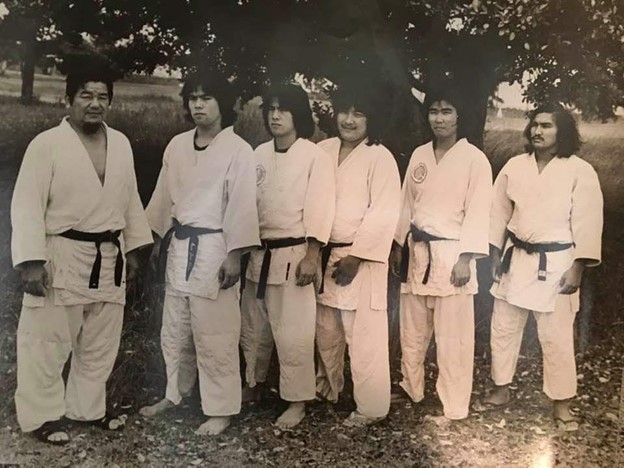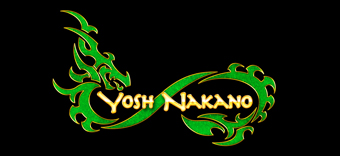The Book of Five Rings
Written around 1645 by Japan’s greatest samurai, Miyamoto Musashi, this is required reading for Japanese businessmen and the Navy Seals. The people in this section exemplify his thought process for developing strategy whether or not they have read this book. Great minds think alike.
Asian American & Pacific Islander Month
David vs. Goliath: Keith Nakasone vs. Ganeko
It’s spring of 1974 and time for the annual Okinawa High School Judo Championship Tournament at the Naha Police Gym. The perennial champions are either between powerhouses Okinawa Koko or Conan Koko. The format is a five man team match with the winning team advancing. There are no weight classes.

Sensei Tsuruo Fukushima, Burt & Keith Nakasone, Ray Dumapay, Mel Chiba, & Mike Dumapay. Missing Yosh Nakano
Okinawa Koko’s players have their hair buzz cut. Conan is a private school and have long hair similar to ours. We are a mixture of Okinawan and Filipino American team representing Kubasaki High School.
Depending on the draw, we would be eliminated by either one of the powerhouses. This year we met Conan in the semi-finals. The undefeated captain of Conan is massive. Ganeko weighs 400 lbs. in a 6’ frame. To put that into perspective, I tried to walk past a 450 lb. Doyle Brunson once and he bumped me with his belly. I felt like I had walked into a brick wall as he gave me a knowing smile at the look of shock on my face. If Ganeko doesn’t throw his opponent, his weight brings them to the mat and then it’s all over. His opponent is powerless to escape.
Our team is not too shabby. The Nakasone twins are world-class athletes that trained in Kumamoto with Yasuhiro Yamashita who won 5 gold medals in international competitions including the 1984 Olympic Gold in Los Angeles. Ray and Mikey Dumapay placed 3rd and 2nd respectively in the U.S. High School National Championships. Mel Chiba and I were the weakest and rotated in the matches.
In this match, I was 1st up. My opponent was tall and slender. I have 2 go to techniques. My throw is the morote seoi nage (1) Seoi-nage – Basic principles – YouTube. The one most often seen on the screen is the ippon seoi-nage. My best foot technique is the kouchi gari (1) kouchi gari – YouTube. I immediately faked the morote and as he braced back, I caught his lead foot with the kouchi. He went down on his back and since this was the 1st time, I had accomplished this move this quickly, I now proceeded to go into a chokehold until I saw the referee out of the corner of my eye have his armed raised signaling an ippon or winner. I was surprised but I would take it.
When it comes down to the 5th and final match, we are tied. It is now Keith against the massive Ganeko. Keith is 5’6” and 135 lbs. It is a mismatch. Keith keeps tugging on Ganeko’s lead sleeve and keeps him from getting a grasp with his other hand. He knows if Ganeko should get a grip, he is finished. As Keith keeps moving left and right fending off Ganeko’s outstretched arm, he also moves back trying to get him off balance. Eventually Keith does catch him with a foot technique that knocks Ganeko off balance and drops him to his knee to regain his balance. It’s ruled a wazari or half-point. This was enough to carry him to a win by continuing the same strategy of tugging back and forth and avoiding Ganeko from getting a grip with his left hand.
It is one of the most historic and greatest matches ever played, especially since competition is now held with weight classes.
We lost in the finals to Okinawa Koko, but we were ecstatic about finally reaching the finals. After the tournament, the Conan sensei lined up his team on the mat in view of the entire gym and slapped each player hard on the face after which they bowed and apologized. We all felt bad about that but that was not unexpected.
The next year and the following year, the KHS Judo Team won the High School Championships. Ray and Mikey Dumapay, Fred Freed and Tommy Yamamoto had grown up to be studs!
Keith Nakasone (born January 20, 1956 Okinawa, Japan)
Keith Nakasone has an identical twin brother named Burt, who was also a prolific athlete and judoka. They decided they didn’t want to compete against each other in college, so only Keith went to San Jose State and trained under the legendary Yosh Uchida.
Keith won 4 NCAA Championships from 1974-1977 competing for San Jose St. and 4 U.S National Championships in 1975, 1977, 1978, & 1979. He was also the captain of the 1980 U.S Olympic Judo Team. The U.S chose to boycott that Olympic and he was awarded a Congressional Gold Medal as a member of the 1980 Olympic team.
He is inarguably the best American Judoka.



